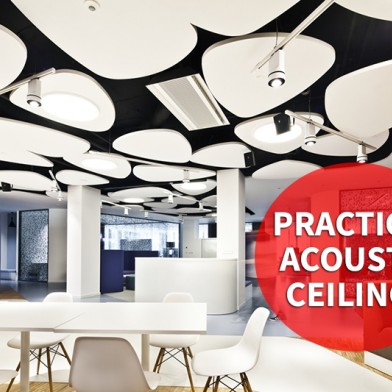Practical acoustic ceilings
- 17 October 2022 23:22:57
- Reviews: 0
- Views: 371
-

In this article, we will introduce you to a wide area of applied acoustics, the problem of acoustic ceilings. Their application is very diverse, they serve many purposes, have a variety of forms, solve different problems and work according to several principles. First, we'll look at more general acoustic patterns to figure out how to protect against noise and whether it should be isolated or diffused. Next, we will show the types of materials for the insulation of suspended ceilings, their characteristics and, finally, the specific practical application in different rooms.
Suitable material thanks to knowledge of acoustics
The first step is to find the right material. According to acoustic knowledge, we have a choice of two typical acoustically useful materials. These are insulating and cultivating materials. Insulators take advantage of the fact that sound loses energy as it moves from one material to another. Therefore, it is simultaneously dense, but mostly composite, consisting of many small fragments, between which sound penetrates and transfers its kinetic energy to them. Grow materials can be lighter and often have a textured surface. Their main task is to scatter sound so that it does not reflect.
Both types of material are used in the implementation of ceiling acoustic ceilings. The most common examples are pressed acoustic boards or mineral wool for insulation, and acoustic polyurethane foams, resembling polystyrene, for sound dispersion.
Do you need an architect?
When we are dealing with a specific implementation of ceiling acoustic ceilings, we must always adapt it to the given space. It is best if the acoustic properties of the room are already included in the architectural design. This saves a lot of work and money from subsequent touches and repairs. In addition to functional properties, of course, visual aesthetic design is also important. Acoustic solutions can serve as a distinctive aesthetic element, especially in large spaces such as industrial halls, shopping malls or open space offices. Of course, this depends on your intentions regarding the space, but just as a storekeeper in a screw shop can read Virgil in the original, so the ceilings of a production shop can please the eye.
Technical solution for a small room
In the case of common areas, residential, office, as a rule, with low ceilings, the simplest is a common suspended ceiling. The acoustic material is attached directly to the top material. If we have more free space, we can use an air gap. A layer of air insulation, very simple in principle, makes insulation many times more effective. The acoustic material is then attached not directly to the wall or ceiling, but to a suspended or fixed mesh.
The effectiveness of grid solutions is significantly reduced by the so-called acoustic bridges. These are places where any sounding material penetrates the insulating layer. A good example is risers in a prefabricated house. The grille should be attached to the surrounding walls, for example, so that it receives a minimum of sound waves from the ceiling. But if the aforementioned riser breaks through such insulation, then the sound will simply pass through it and "elegantly" bypass our insulation. You must be careful with this.
Halls, offices and shopping centers
Too much space is also a problem. Especially in new sheet metal and concrete structures of large buildings such as shopping malls, warehouses, factory floors, office buildings, etc., cladding alone is often not enough or impossible to implement. The reason is often different technical installations, such as air conditioning and ventilation systems, fire distribution or lighting systems, which break up a single surface. But mostly they also reflect sound very well.
In such rooms, the best solution is to suspend the acoustic material in the space. This brings with it several benefits. On the one hand, thanks to the available colors, surface treatment and easy moldability, they can be a desirable aesthetic addition, on the other hand, by adjusting the height, it is possible to precisely select the target frequencies for absorbing and spreading sound around the room. Last but not least, it is a very practical solution that can be easily dismantled at any time, whether for renovation, maintenance or disposal.
Finally
If the budget allows, of course, you can combine both methods, suspended panels and insulation directly on the ceiling. In practice, however, this is often not necessary, since both methods are usually quite effective on their own, and additional insulating layers only increase the cost of the building, but do not improve the acoustics further. No matter where noise bothers you, finding the right solution is now easier than ever.


